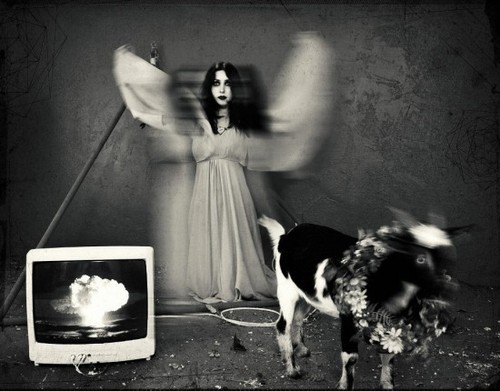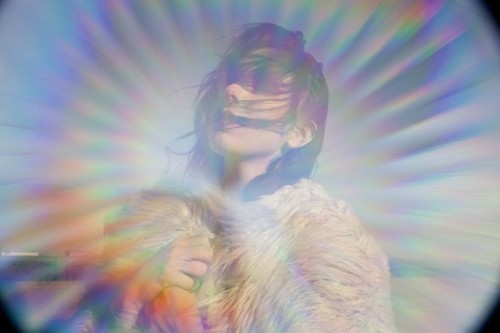CVLT Nation Interview with Chelsea Wolfe


Photo by Darla Teagarden, wardrobe by Black Swan Theory & Bloodmilk, Austin, TX
From day one, CVLT Nation has been a fan of Chelsea Wolfe and we are super happy to share with you our first interview with her. Chelsea’s new album Pain Is Beauty is out now on Sargent House.
What was the recording process like for Pain is Beauty and how did the experience differentiate itself from prior recordings? Also, the album incorporates a stronger electronic element, bearing a different sound from what fans have come to expect. What powers and influences brought about this change?
CHELSEA WOLFE: I met my bandmate Ben Chisholm about four years ago, right around the time when I desired to bring some sort of electronic element into the band. He’s into analog synths and electronic beats and he’s really brilliant and multi-talented. Needless to say, he was a perfect fit. I found that we wrote songs together easily and we started messing around with some electronic songs that I originally thought we’d use for a side project…but I realized over time that I really didn’t want to put limits on this project, so we eventually started playing some of those songs live and I had a lot of fun with their energy. I knew they’d be the base for this new album.

Photo by Kristin Cofer
With each new album cover, you have obscured your features less and less. With Pain is Beauty you are front and center, wreathed in spotlight. How does this visual motif factor in with the album’s sound?
The title “Pain is Beauty” is pretty open to interpretation, but for me it’s about a process of overcoming. There is a regeneration process in forest fires in which the fire creates room for new growth on the forest floor, and I see that process reflected in humanity as well. Life will always bring us hard times and challenges but when we go through the fire and fight to overcome we can come out on the other side stronger, and with a more beautiful perspective. In relation to music, performance and visuals, I’ve always struggled to reconcile my love for writing and recording music with my stage fright and dislike of being up in front of people, so in the past I would obscure myself in the artwork and onstage, wearing a veil and trying to become invisible. I knew I needed to be brave and get over that a bit, especially with the ideal of this album being about overcoming and healing, so I tried to convey that in the artwork.
Having seen you at Club Congress in Tucson, I was curious to see how the new material translated live. Needless to say, I was impressed. That being said, what steps did you take in bringing your new sound to your audience in such an intense form?
My band and I had a couple months this summer to work the new songs out, but when it comes to actually playing them at a show, it’s a different story and the kinks have to be worked out. The first few shows of that US tour were really tough because it was something very new. Even if we play the same songs, each tour is a little or a lot different and it takes some time to fall into the groove. Anyway, I love the combination of electronics and live instruments…drums, guitars…so we found a balance within that and we pour as much energy into the performance as possible.
You released Apokalypsis, Unknown Rooms and Pain is Beauty in relatively quick succession, should we expect any releases throughout the coming year?
I don’t know yet – I’m constantly writing and culling songs and there are a lot of ideas and a few different sound projects I’m slowly working on, but I don’t like to rush myself or my music. Honestly, I would like to explore doing a couple more Pain is Beauty tours next year in a different form before I release something new – maybe something more intimate and quiet. We’ll see…
Additionally, are there specific writers whose work finds its way into your lyrics and mentality when it comes to your music?
Any book I read that I’m really into ends up being reflected in my music. I love when writers have a special sense of detail that opens up my mind in a new way. When I read D.H. Lawrence books – even though he is known for his commentary on family relationships I believe – I usually take away perspective on the relationship between humanity and nature, and his attention to details of nature, color, and life rhythms. That sort of thing finds its way into my lyrics and mentality for sure. “Feral Love” was inspired by a passage from Sons and Lovers where a character asks – who would be more afraid, the men of the forest who were confronted with the open space, or men of the open space suddenly confronted with a dense forest? It made me think about instinctual life and love, human as an animal; a survivor.
What is your earliest memory of knowing music was your calling?
My earliest memory is of being around 6 or 7 years old in my backyard during a sudden downpour of rain. I initially started to run inside but decided to stay in the rain and just listen. The sound of the rain, some ambulance siren in the distance and dogs howling at the sound of the siren – it all came together in such an perfect way, so I went inside and wrote a few pages about it. My childhood life was foggy, confusing and secretive so I would watch the world news for hours to find some reality. I would cry for hours after watching stories about rape camps in African countries or some other horrible event, feeling that the world was so fucked up and I couldn’t do anything about it. I just knew I that understood human sadness in a certain way and decided to write about it because of my incapability to be some sort of activist as I was unbearably shy about talking to others. I felt like I could at least try to shed light on the two sides of every story, the reality side, the dark side. When my parents divorced, my dad eventually got another house and built one of the rooms into a home studio for his country band. I’d hear them recording or working out Fleetwood Mac covers and asked my dad to teach me how to record. I recorded a weird cover of “It’s my Party” at age 8 or 9 and it sparked something in me…from then on I never stopped recording and writing. I still like doing cover songs, too!
If you could have a conversation with one of your dead heroes, who would it be and what would the conversation be about?
I think it would be great to talk for hours with Vladimir Vysotsky or Selda Bagcan – I could learn a lot from either of them.
You are really supportive of underground clothing & jewelry designers. Why is this important to you?
I’m just drawn to certain designers’ aesthetics, and some of them happen to be more underground. I adore Ovate and I also love Ann Demeulemeester. I love when designers create a world you can become part of through their clothing and it’s so rad when you can continue to collect a certain designer’s pieces because they just keep creating more dreamy things each season. I’ve never been one to collect records or other objects; clothes and shoes are the only things, I guess. It’s been really great to meet some of these wonderful creative minds when I’m in different places on tour, like An and Filip of AF Vandevorst in Belgium, J.L. Schnabel of Bloodmillk in Philadelphia, and Katie from K/LLER Collection in New York.
Photo by Darla Teagarden, wardrobe by Black Swan Theory & Bloodmilk, Austin, TX
Talk to us about the challenge of expanding your fan base without alienating your core audience?
I have no idea if I’m doing this right. I feel very lucky to have a group of folks who follow my multiple personality disorder of a musical project. I’ve met so many lovely people at my shows. I love to experiment with new sounds but I have folk roots and will always return to singing with my acoustic guitar no matter what other sounds I mess around with for a while.
How did your relationship with Sargent House start, and why them and not another label?
They embrace outcasts first of all – so someone like me who was just kind of floating out there without any real support. Cathy Pellow at Sargent House took me in and helped me get on a path where I could actually get things done, like tour! When I moved to LA it wasn’t with the intention of finding a label there but it must have been meant to be, and I am very happy and lucky to have released my last two albums with Sargent House – it’s a truly supportive place for art, music, creativity.

